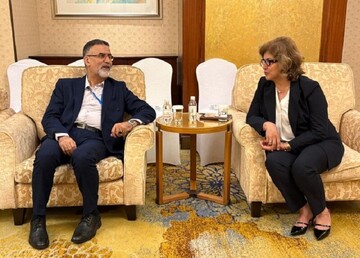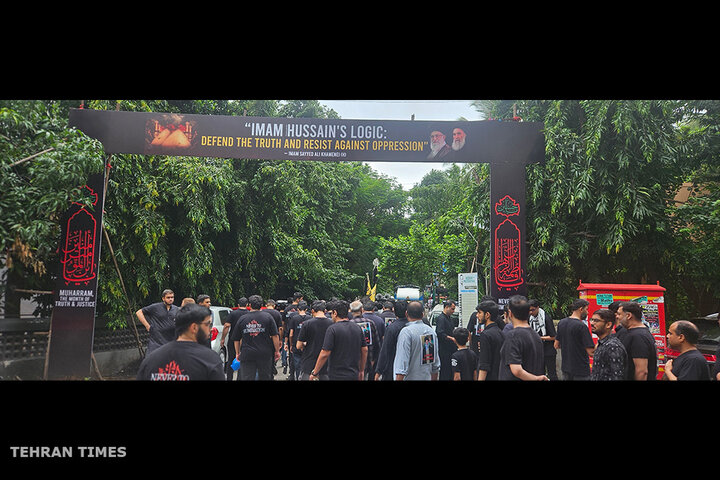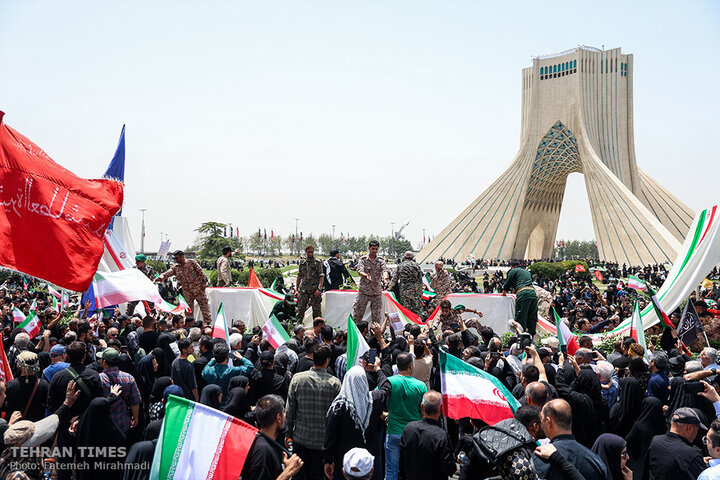-
 2025-07-08 22:08
2025-07-08 22:08
By Soheila Zarfam
Germany’s ‘dirty work’ scandal
Petition calls for Merz to be held accountable over remarks on Israel’s war against Iran
TEHRAN – Controversy is still swirling around the German chancellor's remarks on the Iran-Israel war, with a rapidly growing online petition calling for Friedrich Merz to be held accountable in Germany's Federal Court after he stated that Israel was performing the West's "dirty work" by striking Iranian nuclear, military, and civilian infrastructure.
-

By Xavier Villar
Pezeshkian defends Iranian sovereignty in a key interview with Tucker Carlson
MADRID – The online interview between Iranian President Masoud Pezeshkian and American journalist Tucker Carlson in July 2025 goes far beyond a media spectacle. It becomes a political act of high symbolic voltage.
-

By Faramarz Kouhpayeh
AMIA case and the demand for a fair trial: a response to president Milei
TEHRAN – In response to the June 30, 2025 article titled “The AMIA case: When the roles of murderer and victim are reversed”, Argentine President Javier Milei took to the social media X to repost messages from two representatives of the families of AMIA bombing victims.
-

By Wesam Bahrani
Gaza turns into occupation's graveyard
TEHRAN – The Israeli occupation regime’s soldiers have been caught up in a sophisticated ambush described as one of the “deadliest” since October 7, 2023.
-

By Sondoss Al Asaad
Concern over Barrack’s political storm: Will the trick of former US envoys be repeated?
BEIRUT — Observers took note of the unusually optimistic tone expressed by U.S. Special Envoy to Syria, Thomas Barrack, particularly in light of the heightened rhetoric suggesting that Lebanon could face major escalation if it failed to comply with his proposal to disarm Hezbollah.
-

War criminal Netanyahu can’t nominate Trump for Nobel Peace prize: Zarif
TEHRAN – Iran’s former foreign minister has said Israeli Prime Minister Benjamin Netanyahu that the International Criminal Court (ICC) has issued an arrest warrant against him for war crimes and crimes against humanity in Gaza cannot nominate U.S. President Donald Trump for Nobel Peace prize.
Politics
-

Iran, Qatar affirm commitment to defense ties following 12-day war
TEHRAN – In a high-level exchange, Major General Abdolrahim Mousavi, Chief of Staff of Iran’s Armed Forces, held a phone conversation with Khalid bin Mohammed Al-Attiyah, Qatar’s Deputy Prime Minister and Minister of State for Defense Affairs, solidifying bilateral strategic coordination in the wake of the Israeli regime’s 12-day aggression against Iran.
-

Iran says no talks scheduled with US
TEHRAN – Iran has flatly denied claims by U.S. President Donald Trump that nuclear negotiations are back on the table.
-

How Israeli air defense systems backfired
TEHRAN – A newly surfaced video has raised serious questions about the integrity of Israel’s air defense systems, suggesting that the recent strike on central Tel Aviv may not have been a technical failure, but an act of internal sabotage.
Sports
-

Iran’s women’s basketball aiming for promotion to Asia Cup Division A: Vakili
TEHRAN – Iran’s women’s basketball team power forward Delaram Vakili emphasizes that their primary goal is to secure promotion to the FIBA Women’s Asia Cup Division A.
-

Alvarez named Persepolis’s goalkeeping coach
TEHRAN – Emilio Alvarez has been named as Persepolis football team goalkeeping coach on Monday.
-

Injuries and hurdles: Iran women prepare for Asia Cup Qualifiers
TEHRAN - The Iran Women's National Football Team, under the guidance of head coach Marzieh Jafari, are set to kick off their 2026 AFC Women's Asian Cup qualification campaign in Amman, Jordan.
Culture
-

IRIB initiates intl. action against Zionist regime’s attack on national media
TEHRAN – The legal department of the Islamic Republic of Iran Broadcasting (IRIB) is actively pursuing legal measures regarding the Zionist regime’s attack on the state media headquarters in Tehran.
-

“The Last of the Whale Shark” wins award at SCO film festival
TEHRAN – In the inaugural edition of the Shanghai Cooperation Organization (SCO) Film Festival, Iranian filmmaker Ramtin Balef’s documentary “The Last of the Whale Shark” received the festival’s Special Jury Award.
-

Tehran’s City Theater to host Edward Albee’s “The Zoo Story”
TEHRAN – The one-act play “The Zoo Story” by American playwright Edward Albee will be staged at the Qashqai Hall of Tehran’s City Theater Complex from July 9.
Economy
-

Iran ranks as OPEC’s second-largest oil refiner
TEHRAN - Iran has become the second-largest oil refiner among OPEC member states, with a daily refining capacity of 2.237 million barrels — accounting for 16 percent of OPEC’s total and 2.1 percent of global refining capacity, according to the latest OPEC Annual Statistical Bulletin.
-

Iran’s quarterly non-oil export to Iraq hits $1.905b
TEHRAN- Iran exported non-oil commodities valued at $1.905 billion to Iraq during the first quarter of the current Iranian calendar year (March 21-June 21), according to the head of the Islamic Republic of Iran Customs Administration (IRICA).
-

Overhaul operations of 11 South Pars platforms completed
TEHRAN - Pars Oil and Gas Company (POGC) has successfully completed major overhauls on 11 offshore platforms in the South Pars gas field, as operations continued without interruption during a recent 12-day regional conflict, according to the managing director of the company.
Society
-

Iran Digital National Plan wins WSIS Champion Award
TEHRAN – The International Telecommunication Union (ITU) has awarded the Iran Digital National Plan project as one of the World Summit on the Information Society (WSIS) champions 2025 in the E-Business category.
-

Over 80% of Afghan refugees voluntarily return home
TEHRAN – From the beginning of the current Iranian year, March 21, till June 27, a total of 717,658 Afghans have returned to Afghanistan; more than 80 percent of them were dispatched voluntarily.
-

Sanctions and geopolitical tensions undermine climate cooperation: FM Araqchi
TEHRAN – Iranian Foreign Minister Seyed Abbas Araqchi has said that sanctions and geopolitical tensions undermine climate cooperation and hinder coordinated action.
Tourism
-

Iran suggests China abolish visa requirements for its tourists in reciprocal move
TEHRAN – Iran has called on the Chinese government to lift visa requirements for Iranian nationals wishing to visit China, in a move aimed at deepening bilateral cultural and tourism ties.
-

11,000-year-old secret revealed: Boars transported across Zagros for ritual feasts in western Iran
TEHRAN - A study by an international team has revealed that pre-agricultural communities at the Early Neolithic site of Asiab, near Kermanshah in western Iran (~9660–9340 cal BCE), engaged in complex logistical efforts to provision large-scale ritual feasts.
-

Iran, Tajikistan should be pioneers in unifying Persian-speaking world
TEHRAN—Iran and Tajikistan, as two wings of Persian culture, should be pioneers in unifying the Persian-speaking world, said Hojjatollah Ayyoubi, head of Tourism Ministry’s Center for International Affairs.
International
-

Exclusive: Expert says Israel would have been destroyed had it attacked Iran without Western backing
TEHRAN - In an exclusive interview with Tehran Times, Dimitri Lascaris, a prominent Canadian lawyer, journalist, and human rights activist, offers a powerful critique of the recent Israeli and U.S. military strikes against Iran.
-

Gaza turns into occupation's graveyard
TEHRAN – The Israeli occupation regime’s soldiers have been caught up in a sophisticated ambush described as one of the “deadliest” since October 7, 2023.
-

Concern over Barrack’s political storm: Will the trick of former US envoys be repeated?
BEIRUT — Observers took note of the unusually optimistic tone expressed by U.S. Special Envoy to Syria, Thomas Barrack, particularly in light of the heightened rhetoric suggesting that Lebanon could face major escalation if it failed to comply with his proposal to disarm Hezbollah.
Most Viewed
-
Exclusive: Jeffrey Sachs reveals real motives behind Israel’s raid on Iran
-
A look at Israel’s strategy to Balkanize Iran and why it will fail
-
Yemen strongly pounds Israel with missiles and drones
-
BRICS backs Iran
-
Why Iran emerged victorious in its war with Israel
-
Pezeshkian says Iran open to dialogue, but finds it hard to trust US again
-
How Israeli air defense systems backfired
-
Iran suggests China abolish visa requirements for its tourists in reciprocal move
-
A timeline of the Iran-Israel war
-
Leader blurs lines between faith and nation with ‘Ey Iran’ performance
-
Iran to offer $360m in private mining investment packages by Mar. 2026
-
Exclusive: Expert says Israel would have been destroyed had it attacked Iran without Western backing
-
Germany’s ‘dirty work’ scandal
-
Gaza turns into occupation's graveyard
-
Israel escalates aggression on eve of Barrack visit: Will the war resume?












